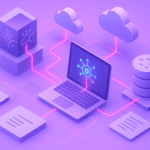Every enterprise now faces Shadow AI, which is the use of AI tools, models, and integrations without IT approval or security oversight.
And the scale of the problem is wild.
Tens of thousands of AI services are now available on the market, and employees aren’t waiting for permission to use them. The list of use cases for these tools is virtually endless. Sales reps paste client contracts into AI tools to summarize key points for meetings, exposing confidential pricing structures and proprietary terms. Marketing teams use ChatGPT to generate campaign content with customer data. Developers integrate third-party AI APIs into products without IT review. HR managers deploy AI-powered resume screening tools that legal teams have never vetted. Product managers use Claude to summarize internal strategy decks before sharing them with vendors.
This Halloween, we’re less concerned with haunted houses than with your haunted infrastructure.
What Lurks in the Shadows
Acuvity’s 2025 State of AI Security Report found that nearly half of security and IT leaders expect an incident caused by Shadow AI within the next twelve months. That number alone captures how much AI activity has escaped official oversight. What exists in the shadows isn’t a few isolated experiments. It’s a parallel layer of computation that operates across enterprises without consistent visibility, ownership, or control.
Teams deploy large language models on cloud instances that never appear in security inventories. SaaS platforms quietly enable AI-driven features that access internal data once users authenticate. Employees connect external AI tools to company accounts, allowing models to pull from shared drives or ticketing systems with no logging or audit trail. Over time these practices create an expanding perimeter of unmonitored endpoints that process sensitive data while appearing entirely normal to legacy controls.
The same report shows that 70 percent of organizations admit their AI governance programs are still immature. That gap leaves internal models, third-party copilots, and embedded AI features running with little coordination between IT, compliance, and security. Logs remain incomplete, model memory persists indefinitely, and few companies can trace where their data travels once it enters an AI workflow.
This is what lives in the shadows of enterprise AI: systems that function beyond visibility and security. They learn, store, and exchange information in ways that governance and security frameworks were never designed to manage. Each layer that remains unaccounted for increases the likelihood that the next AI-related breach or compliance failure won’t come from a targeted attack, it will come from the company’s own technology operating outside its field of vision.
Agents That Act in the Dark
Autonomous agents magnify the problem exponentially. Once granted API keys or workflow permissions, they can trigger tasks, invoke other models, and write to databases—often without human review. Dtex Systems’ 2025 threat advisory warned that persistent agents with unbounded permissions can perform large-scale data operations “without attributable human initiation.”
Consider what this looks like in practice: An agent with Slack permissions begins by answering simple questions about company policies. Over time, it expands its context window by recursively pulling entire channel histories to improve response accuracy. It accesses HR discussions, strategic planning threads, and confidential project channels, not because it was programmed to exfiltrate data, but because it was optimized to be helpful. No single action triggers an alert. The data never leaves the corporate network. Yet thousands of sensitive conversations now exist in a vector database that was never designed with retention policies or access controls.
For enterprises already struggling to audit user actions, non-human actors with growing autonomy create new governance gaps. Traditional identity controls break down when the “user” is software that never logs out, never takes vacation, and operates across dozens of systems simultaneously. The question isn’t whether the agent has permission, it’s whether anyone understands the cumulative scope of what it’s been authorized to do.
Memory That Never Dies
As of 2025, free and Plus users of popular AI platforms have their chat history stored indefinitely by default unless manually deleted. While users can opt out of model training through a separate toggle, prompts and responses remain stored in chat history. Once datasets are used for training, they become part of the model’s knowledge base, making retrieval or deletion nearly impossible.
Shadow AI operates as an invisible data hemorrhage because employees often perceive AI interactions as temporary queries rather than permanent data transfers. When a marketing manager pastes customer segment analysis into ChatGPT to generate campaign ideas, or when a developer shares proprietary code with an AI assistant to debug a function, they typically view these as momentary consultations.
The problem is one of defaults and awareness. While “Temporary Chat” mode exists and can prevent data retention, it must be manually activated for each session. A 2024 EU audit found that only 22% of users are aware of opt-out settings. Employees using Shadow AI tools rarely enable these protections, meaning sensitive corporate data accumulates in external systems by default.
Once a user types or pastes sensitive information into an unvetted, public AI tool, they lose control over that data. Organizations have no visibility into what was shared, no ability to enforce deletion timelines, and no way to verify whether proprietary information was used for model training, even if employees later attempt to delete their chat history.
Why Traditional Security Fails
Security tools built for static infrastructure can’t see any of this. They were designed for a world where data moved in predictable ways, such as files stored in databases, emails sent through corporate servers, and applications running on managed endpoints. AI shatters those assumptions.
- Data Loss Prevention (DLP) inspects files, not prompts. A DLP system can catch an employee trying to email a customer list or upload a spreadsheet to Dropbox. But when that same customer data gets pasted into a ChatGPT prompt, or fed into a local model for “quick analysis,” DLP sees nothing. The data isn’t leaving in a file format it recognizes. It’s leaving as text in an API call, often encrypted, often to a domain that looks legitimate because it is legitimate, just not approved for processing regulated data.
- Firewalls filter IP addresses, not inference traffic. Traditional network security blocks known-bad domains and restricts outbound connections. But AI traffic flows to cloud providers, SaaS platforms, and API gateways that security teams have already whitelisted for other purposes. An employee using an AI coding assistant isn’t connecting to “malicious-model-exfiltration-site.com”, they’re connecting to GitHub, Anthropic, or OpenAI. The traffic is HTTPS-encrypted. The destination is trusted. The firewall has no basis to block it, and no visibility into what’s being sent.
- CASB platforms track SaaS usage, not local model servers or MCP connectors. Cloud Access Security Brokers monitor how employees use sanctioned applications like Salesforce or Office 365. They can’t see the open-source model running in a Docker container on someone’s laptop. They can’t detect when a developer uses the Model Context Protocol to connect an AI agent directly to internal repositories, Slack channels, or ticketing systems. These connections happen at the application layer, below the CASB’s line of sight, using credentials that are legitimately provisioned.
- Identity and Access Management (IAM) assumes actions have human owners. When an employee accesses a file, IAM logs their username, timestamp, and what they did. But when an AI agent accesses that same file, perhaps because a developer gave it read permissions to “help with documentation”, whose action is that? The developer who created the agent? The service account the agent runs under? The VP who approved the project budget? Traditional IAM has no concept of delegated machine autonomy. It can’t distinguish between a human retrieving a document and an agent recursively indexing thousands of documents to improve its responses.
The architecture of AI breaks the fundamental assumptions that perimeter and identity security rely on: that actions begin with humans, that data stays within observable boundaries, and that compute happens in places IT controls. When models initiate calls, generate content, and learn continuously, when they operate with the agency of users but the persistence of infrastructure, conventional controls simply don’t register the activity.
The Cost of Operating in the Shadows
What lurks in the shadows of enterprise AI isn’t malicious intent, it’s unchecked proliferation. Employees chase productivity gains, vendors emphasize capabilities over controls, and governance struggles to keep pace with adoption. The result is a sprawling AI ecosystem that operates beyond visibility: unmanaged endpoints, autonomous agents with broad permissions, and persistent data stores that retention policies cannot reach.
The common thread across Shadow AI, autonomous agents, and data security is the same: these systems act without oversight. They make decisions, access resources, and retain information long after humans assume the interaction has ended. Security teams cannot protect what they cannot see. Compliance teams cannot audit what leaves no trail. And when an incident occurs, such as leaked customer data, a compliance violation, or a model accessing unauthorized resources, the organization discovers too late that it had no mechanism to prevent it.
Addressing this doesn’t require abandoning AI. It requires treating visibility as foundational rather than optional. Organizations need continuous discovery to identify every AI endpoint in use, runtime monitoring to track what models access and generate, and enforcement mechanisms that apply data governance policies at the point of use, not after the fact.
The question isn’t whether AI delivers value. It does. The question is whether you can account for what it’s doing across your environment, especially in the spaces you haven’t looked yet.





